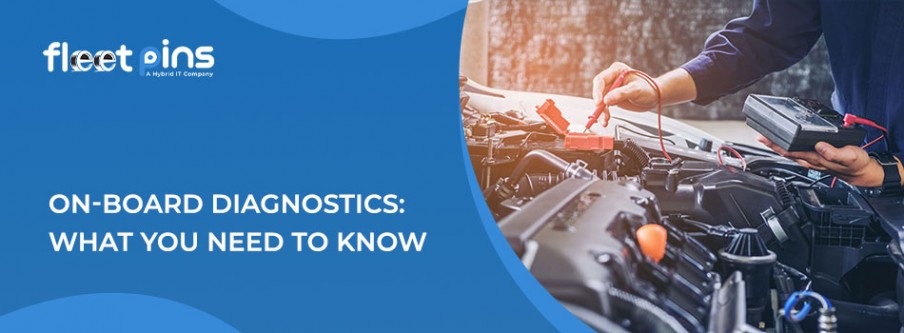
- On 2025-02-19
On Board Diagnostic What you Need to Know
OBD relies on sensors to identify problems in various vehicle components. These sensors communicate with an embedded computer system inside the vehicle. Most drivers receive feedback from these sensors and the computer system through the dashboard. Malfunction indicator lights (MILs), such as the check engine light, are activated by the OBD system.
Modern vehicles are equipped with sensors that monitor everything from oil levels and fuel injection systems to tire pressure. The OBD system collects and processes data on vehicle performance and functionality.
While this information does not directly appear on the dashboard, a scanner can be used to access diagnostic trouble codes (DTCs), offering detailed insights for targeted repairs and maintenance.
At Fleet Pins, let’s discuss an overview of what OBD is and how it can be helpful. Let’s see the advantages they offer in terms of cost efficiency, safety, and adherence to emissions and safety regulations.
How does OBD work?
The OBD system includes sensors that continuously track the vehicle’s essential systems and components. It manages engine functions while generating alerts and diagnostic trouble codes.
Here is a closer examination of its key components:
Electronic Control Units (ECU):
These units process data for the OBD system. They have dual roles—managing the engine, transmission, and braking systems while also collecting performance data, triggering MIL alerts, and generating diagnostic codes.
Sensors:
These measure parameters such as engine temperature, air intake, exhaust levels, tire pressure, traction, and vehicle speed, relaying data to the ECU.
Actuators:
Responsible for controlling and adjusting various vehicle functions based on ECU commands. For example, they regulate fuel injectors and throttle valves to optimize engine performance.
Malfunction Indicator Lights (MILs):
These dashboard icons notify drivers of issues, ranging from oil levels to engine performance. They serve as alerts rather than diagnostic tools, prompting drivers to seek maintenance.
Diagnostic Link Connector (DLC):
This port allows diagnostic tools, like OBD scanners, to retrieve trouble codes. Although some drivers can use this feature, professional mechanics typically connect scanners to the DLC for precise diagnostics.
OBD-II Sensors:
These devices display diagnostic trouble codes when connected to the DLC. Available in handheld forms, some professional garages use advanced units with additional software for in-depth diagnostics and repair support.
Initially designed to oversee critical engine components, OBD systems have significantly evolved. Today, they manage safety systems, among others.
OBD-I vs. OBD-II
OBD-I and OBD-II represent two generations of onboard diagnostics systems, differing in standardization, integration, and legal requirements.
The first-generation OBD-I system was used until the mid-1990s, primarily for monitoring emissions control systems.
However, OBD-I lacked standardization, requiring specialized tools for different vehicle brands, making diagnostics complex. OBD-II emerged in the mid-'90s to deliver more accurate emissions readings.
Unlike its predecessor, OBD-II was standardized per Environmental Protection Agency regulations.
OBD-II introduced improved integration, featuring uniform connectors, which allowed mechanics to diagnose any vehicle brand using the same scanner.
Additionally, it expanded beyond emissions control, monitoring engines, brakes, and other systems while providing more detailed diagnostic codes. Due to its efficiency, OBD-II became mandatory for all vehicles sold in the U.S. starting with the 1996 model year.
What can OBD be used for?
OBD collects extensive data on vehicle performance and efficiency, which can be accessed through the standardized OBD port. Some of the key insights provided by OBD include engine RPM, fuel system status, oxygen sensor readings, coolant temperature, vehicle speed, and emissions control data. This information serves several purposes:
Driver Behavior Monitoring:
The OBD system check helps analyze driving patterns, such as speed, acceleration, and braking habits. This information is crucial for improving driver safety and encouraging responsible driving practices.
Emissions Control:
OBD systems play a significant role in emissions testing by ensuring compliance with environmental standards. They continuously monitor emissions-related components and systems.
Supplementary Instrumentation:
OBD data can be used to enhance dashboard displays, showing real-time fuel efficiency metrics. Enthusiasts and professional drivers often use this data to fine-tune vehicle performance.
• Telematics: OBD-integrated telematics systems enable remote vehicle tracking and real-time diagnostics. These features benefit fleet management, insurance pricing, and vehicle owners looking for driving insights. An OEM telematics platform can be installed to enhance fleet management capabilities.
• Maintenance and Repairs: Technicians utilize OBD data to quickly identify issues, reducing diagnostic time and repair costs while improving accuracy.
OBD scanners are available for drivers who wish to access diagnostic codes and performance data for DIY maintenance or to estimate repair costs.
The Benefits of OBD for fleet management
On-board diagnostics simplify fleet management, reduce maintenance costs, and facilitate compliance with safety and emissions standards. When combined with GPS fleet tracking software, OBD systems enable businesses to efficiently oversee their fleet operations.
Here are three key advantages of OBD in fleet management:
Improved Diagnostics
OBD accelerates vehicle diagnostics by providing mechanics with precise information about potential issues. This allows for targeted repairs instead of relying solely on dashboard alerts.
Diagnostic trouble codes can detect issues before they result in major breakdowns, enabling preventive maintenance. Early diagnosis helps fleets maintain vehicles in optimal working condition and enhances overall efficiency.
For improved diagnostic insights, How Dash Cameras Impact Your Car Insurance can help monitor driving behavior and reduce accidents, benefiting fleet diagnostics.
Improved Compliance
From 2027 to 2032, the Environmental Protection Agency plans to enforce stricter emissions regulations for light-duty and medium-duty vehicles, making exhaust monitoring even more essential. OBD systems continuously scan emissions-related components to ensure vehicles meet regulatory standards.
When a vehicle surpasses allowable emission levels, mechanics can use diagnostic codes to pinpoint and address the problem. This proactive approach helps organizations remain compliant and avoid penalties associated with emissions violations.
Learn how Benefits of Implementing GPS Trackers in Fleet Operations can complement OBD systems to track and manage fleet compliance effectively
Reduced Costs
Accurate diagnostics minimize vehicle downtime and streamline the repair process by enabling faster issue detection and resolution. With an effective OBD system, vehicles spend less time in the shop and avoid costly, undiagnosed repairs.
Additionally, OBD compliance management reduces fines related to environmental regulations. By consistently adhering to emissions standards, organizations can prevent penalties that may impact their financial stability.
Fleet operators can further cut costs by integrating OBD with GPS tracking systems. This combination allows for efficient maintenance scheduling, optimized equipment routing, and better asset utilization.
Find out how Fleet Dash Cams Reduce Driver Distractions can help improve fleet safety, reduce accident-related costs, and boost overall efficiency.
Conclusion
On-board diagnostics play an essential role in fleet management, helping businesses detect vehicle issues early, reduce maintenance costs, and maintain compliance with emissions regulations. By integrating OBD with telematics and GPS tracking, companies can operate at peak efficiency, monitor vehicle performance in real time, and optimize fleet utilization.




